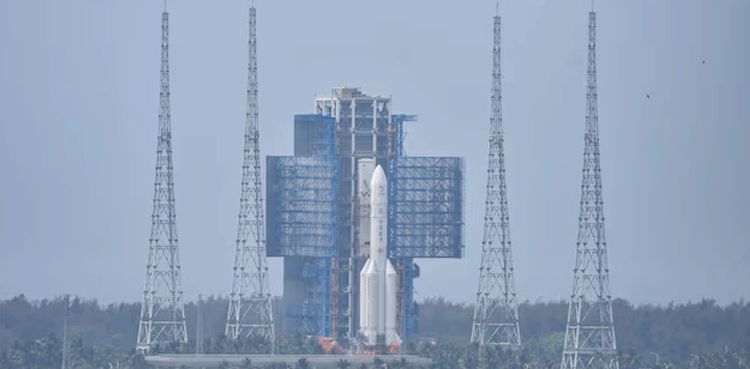
China landed an uncrewed spacecraft on the far side of the moon on Sunday, a landmark mission aiming to retrieve the world’s first rock and soil samples from the dark lunar hemisphere, China’s space agency said.
The landing elevates China’s space power status in a global rush to the moon, where countries, including the United States, are hoping to exploit lunar minerals to sustain long-term astronaut missions and moon bases within the next decade.
The Chang’e-6 craft, equipped with an array of tools and its own launcher, touched down in a gigantic impact crater called the South Pole-Aitken Basin on the moon’s space-facing side at 6:23 a.m. Beijing time (2223 GMT), the China National Space Administration (CNSA) said in a statement, opens new tab on its website.
The mission “involves many engineering innovations, high risks and great difficulty,” CNSA said. “The payloads carried by the Chang’e-6 lander will work as planned and carry out scientific exploration missions.”
The successful mission is China’s second on the far side of the moon, a region no other country has reached. The back of the moon perpetually faces away from the Earth and is dotted with deep and dark craters, making communications and robotic landing operations more challenging.
The Chang’e-6 probe launched on May 3 on China’s Long March 5 rocket from the Wenchang Satellite Launch Center on the southern island of Hainan, reaching the lunar vicinity roughly a week later before tightening its orbit in preparation for a landing.
Using a scoop and drill, the lander will aim to collect 2 kg (4.4 pounds) of lunar material and bring it back to Earth.
The samples will be transferred to a rocket booster atop the lander, which will launch back into space, tag up with another spacecraft in lunar orbit and return, with a landing in China’s Inner Mongolia region expected around June 25.
If all goes as planned, the mission will provide China with a pristine record of the moon’s 4.5 billion-year history and yield new clues on the solar system’s formation. It will also allow for an unprecedented comparison between the dark, unexplored region with the moon’s better understood Earth-facing side.
China’s broader lunar strategy includes its first astronaut landing around 2030 in a program in which it counts Russia as a burgeoning partner. In 2020 China conducted its first lunar sample return mission with Chang’e-5, retrieving samples from the moon’s near-facing side.
The U.S., with its Artemis program, also envisions a crewed moon landing by late 2026 or later. NASA has partnered with several space agencies including Canada’s, Europe’s and Japan’s, whose astronauts will join U.S. crews on a future Artemis mission.
from International News Today - Breaking News, US News, World News https://ift.tt/UfBQm6u
via IFTTT